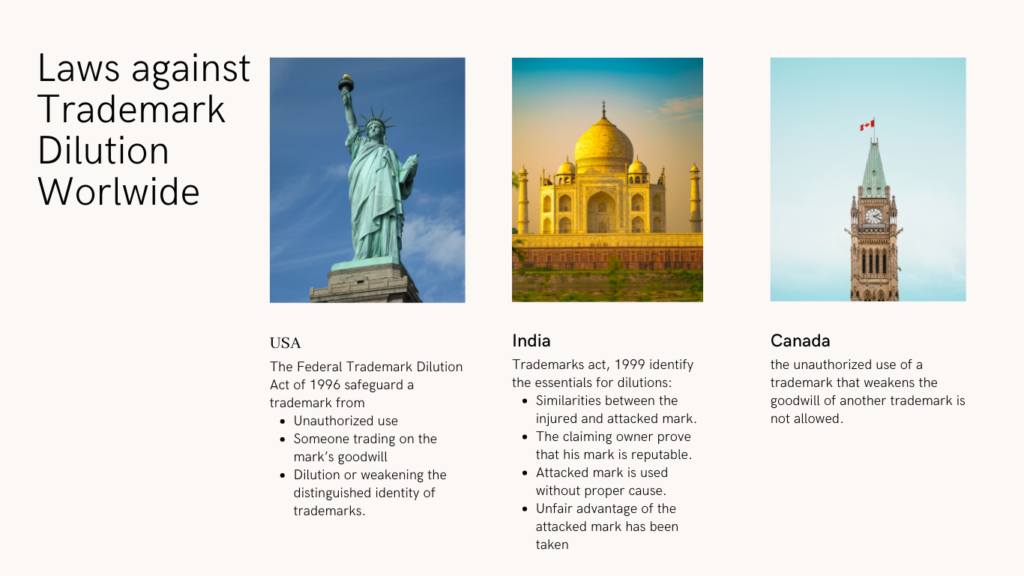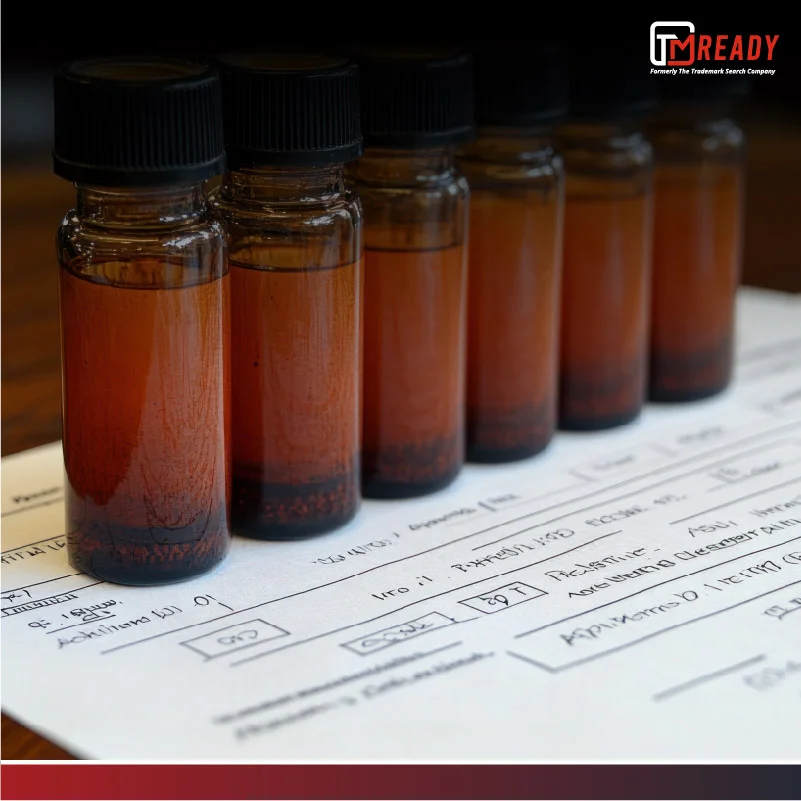Do you own a famous trademark or planning to get one registered for your company? If yes, did you know that a dilution can weaken a famous trademark? This article covers A to Z of trademark dilution and associated laws that make the basis for dilution protection. Also, we will discuss how one can safeguard their mark from dilution.
Table of Contents
ToggleWhat is Trademark Dilution?
Trademark dilution is when the distinctiveness of a well-known trademark is compromised by unauthorized use with or without causing confusion among consumers. This can happen in two ways: blurring, where the mark is connected to products that have no relation to each other, and tarnishment, where the mark is associated with poor or unsuitable goods. In both cases, the value and reputation of a brand gets impacted, leading to a diluted trademark over time.
What are the elements of trademark dilution?
The two elements of trademark dilution are fame and the likelihood of unauthorized mark weakening the famous mark’s image
- Fame: In most nations, either courts or trademark offices determine the actual recognition levels of the mark.
- Likelihood of impugned party’s mark use weakens the distinctiveness of the recognized trademark: The owner of the famous mark needs to prove just the likelihood of dilution and not actual dilution. It is up to the court whether there is an actual diluting or not.
What are the types of trademark dilution?
Trademark dilution can be of various types depending on the harm it causes to the original mark. Moreover, there are three main types of dilution are blurring, tarnishment, and free-riding.
Blurring
It occurs when a famous mark identity is harmed or damaged because of unauthorized use by a third party. The use of a mark by a third party reduces the likelihood of the mark serving as a unique identifier of the owner’s product and hampering its selling capacity. The blurring of trademarks starts when several third parties have applied for or have registered or are using deceptively identical, similar trademarks. Some of the more famous examples of blurring trademarks are Aspirin, Rolls-Royce, Escalator, Thermos, and Cellophane. Unfortunately, the illegal use of these trademarks is rampant in the market, leading to obscurity in trademark rights.
Tarnishment
A trademark is tarnished when the challenged mark in question links the original mark to the products that are of inferior quality. Moreover, the impugned mark reflects the original in a distasteful context that is likely to reflect the owner’s product poorly. Trademark tarnishment is a common problem, especially in countries like India, China, Bangladesh, etc., with several deceitful manufacturers and sellers. They are willing to use the original mark with slight tampering and sell the product at a low cost, severely impacting the owner’s brand equity. Some of the popular examples of trademark tarnishment are Coca-Cola, Starbucks Coffee, etc.
Free-Riding (EU-specific)
Trademark freeriding happens when a trademark owner starts leveraging the benefits of a positive association between the owner and a well-known third-party mark. Trademark freeriding is also referred to as parasitic exploitation by several countries. Therefore, many countries worldwide, including the European Union (EU), consider freeriding an actionable offense. However, freeriding cannot be considered an injury or damage in trademark law as the defendant’s gains do not lead to the plaintiff’s loss. Some examples of trademark freeriding are Red Bull & the Bulldog, L’Oréal/Bellure, etc. illegally associates irrelevant goods or services with the famous mark’s legitimate products.
Legal Framework and Jurisdictions
Global Recognition
Dilution of trademarks is a well-established principle in intellectual property law throughout the world, although the legal provisions and enforcement systems differ from jurisdiction to jurisdiction. Most nations have included provisions for dilution in their domestic laws to safeguard famous marks against uses that would damage their distinctiveness or reputation. These include countries such as the United States, EU member states, South Africa, India, and Japan have enacted definite legal statutes to recognize and sanction trademark dilution.

- USA, European Union, India, Japan, etc. have exclusive laws and regulations that recognize dilution of a mark.
- On the other hand, Canada, Australia, and most South American Countries provide protection against dilution under other laws without any explicit law. For example, In Canada, the unauthorized use of a trademark that weakens the goodwill of another trademark is not allowed.
Trademark Dilution Law in the USA
The Federal Trademark Dilution Act of 1996
FTDA, 1996 provides the right to act in order to safeguard a trademark from
- Unauthorized use
- Someone trading on the mark’s goodwill
- Dilution or weakening the distinguished identity of trademarks.
Under FTDA, 1996; both likely dilution and actual dilution are included to identify and eliminate risks beforehand. So, if someone owns a famous trademark, then he can legally initiate for an injunction against the impugned party diluting the original trademark’s distinctiveness. The entitlement to an injunction is available whether or not there is a likelihood of confusion or economic loss.
Under FTDA, five factors act as evidence of fame of the mark in connection:
- Duration
- Volume
- The geographic extent of marketing and advertising
- The geographic reach of products offered
- The extent of real recognition
Moreover, dilution claims are only valid if the mark at issue was well-known before its unauthorized use began.
Trademark Dilution by Blurring in the USA
The relevant factors that Decide Blurring under FTDA are:
- The degree of similarity between an impugned party’s trademark or name and the famous mark
- The level of the famous trademark’s distinctiveness
- The extent of involvement of the famous trademark’s owner in substantially explicit use of the mark
- The level of recognition and degree of distinctiveness of the famous mark
- If the impugned party intended to associate their mark with the famous mark
- Whether or not there is any actual association between the impugned party’s mark and the famous mark.
The Trademark Dilution Revision Act, 2006
TDRA revised the Lanham Act by removing the necessity to prove actual confusion, competition, or any treble damages. Also, this act provides an option to the famous mark’s owner to seek additional civil action if the impugned party:
- Ist used the trade name or trademark in the market after 2006
- Intentionally traded on the fame of the mark
- Intentionally traded to weaken or harm the distinctiveness of the recognized mark.
Trademark Dilution vs Infringement: The Key Difference
| Trademark Dilution | Trademark Infringement |
| In trademark dilution cases, the goods and services of the impugned trademark need not be similar. | The goods or services offered by the infringer are from a similar sector or geographical location. |
| Deciding criteria are: Dilution by blurringDilution by tarnishment Free-Riding | Deciding Criteria are: Likelihood of confusion/consumer confusion. Geographical area of operation of involved businesses. Similarity in target customer base |
| For example, a company using the name Mercedes for selling watches is trademark dilution as it will weaken the image of the original company. But it will not be regarded as trademark infringement as the sectors are different. | For example, if a company uses the same name and logo to sell the same product, suppose someone uses the name Mercedes for selling cars, it is a case of trademark infringement. |
Protecting Your Brand from Trademark Dilution
Monitoring and Enforcement
To safeguard your brand against dilution, monitoring the market for unauthorized use is crucial on a regular basis. This involves tracking online platforms, social media, and marketplaces for fake products, misuse of your trademark, or unauthorized references to your brand. Brand monitoring tools can facilitate this process. With infringements detected, immediate legal action in the form of cease-and-desist letters or formal suits can scare off offenders and maintain your brand’s uniqueness.
Educating Consumers
Consumer awareness is essential to brand protection. By informing your readers about your brand distinctiveness and the threats of dilution such as counterfeiting spread or deceptive imitations you build loyalty and comprehension. Through blogs, social media, or packaging, sharing this information enables consumers to distinguish and appreciate authenticity, motivating them to support your brand and report misuse.
Strategic Brand Management
Quality and messaging consistency are the driving factors behind a strong brand identity. Make sure your products, customer service, and marketing all reinforce your brand fundamental values. Periodically examine brand elements to remain consistent with market expectations without sacrificing what makes your brand unique. A clear, consistent brand experience reinforces consumer trust and can prevent a diluted trademark.
Conclusion
Trademark dilution statutes are vital in ensuring the distinctiveness and reputation of established brands. They ensure that a brand’s integrity is not compromised by unauthorized uses which may weaken or destroy a brand identity. Through comprehension and proactive prevention of dilution, companies can ensure their brand uniqueness and uphold consumer trust. An undiluted brand builds confidence and conveys reliability and quality, fostering long-term loyalty. In a competitive environment, upholding brand integrity is vital to differentiating and achieving long-term success.




